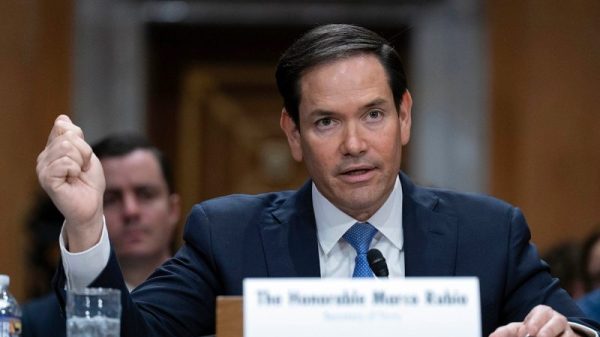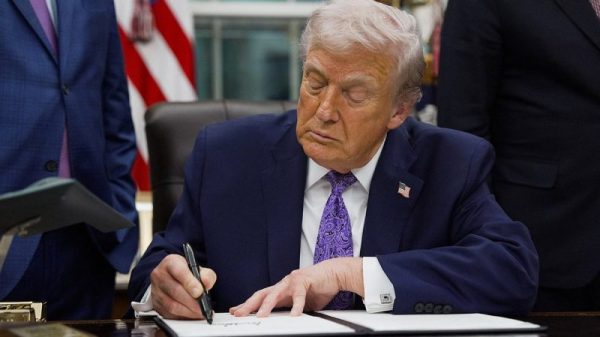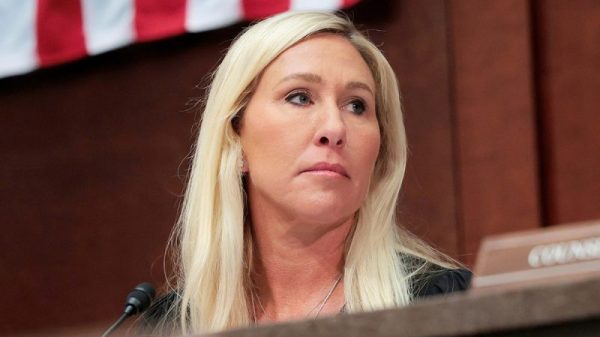Coming into the New York primary in mid-April 2016, Donald Trump was well-positioned in the Republican presidential primary. Over the preceding months, the former president had accrued more than 750 delegates, more than half the total he would need to clinch the nomination and more than 200 more than the second-place candidate, Sen. Ted Cruz (R-Tex.).
Then Trump won his then-home state of New York handily. He not only gained a big chunk of delegates but also accomplished something he hadn’t yet achieved in any other state: He won a majority of the votes. From then on, he kept doing so — after everyone else except Cruz and Ohio Gov. John Kasich had dropped out.
How did Trump leap to the front of the delegate total despite not winning a majority of votes in state contests? In part because the Republican nominating calendar is built to advantage the front-runner, with lots of states giving all or most of their delegates to the person that came in first, even if that was only a victory of 30 percent to 29 percent. And Trump took advantage.
This context is important as we consider the 2024 race, once again featuring Trump as a candidate. In particular, it’s useful to remember how Trump won in 2016 when evaluating claims like the one New Hampshire Gov. Chris Sununu (R) presented on Fox News this week.
“At the end of the day, anyone who thinks that, oh, ‘Trump’s just going to run away with this?’ ” Sununu said. “Look, if seven of those candidates have the discipline to get out, Trump loses.”
It was “the candidates’ job,” he said, to clear the field and “make it a one-on-one race.”
There are “huge opportunities for these candidates to say, ‘I’m going to be the alternative,’ ” he continued, “and make sure the other candidates ultimately know there’s no room for you, and there’s too much at stake with the entire Republican ticket.”
You can see one problem with this strategy immediately, I assume. Good luck to the candidate who decides to tell all the other candidates that they have to get out. If there’s one assumption that it is generally safe to assume about people who seek the presidency, it’s that they have a healthy sense of their own capabilities and importance. Just imagine, say, Vivek Ramaswamy standing up at the next debate and informing the others onstage that the time has come for them to mosey off into the sunset. I mean, he might — but it won’t work.
But even beyond that, even if every candidate besides, say, Florida Gov. Ron DeSantis woke up tomorrow and decided they’d seen enough of Dubuque, the math simply doesn’t add up. This is the important thing about the 2016 precedent: Trump stayed on top of the field while mostly winning states by modest margins. In mid-April 2016 — even after most of the other candidates had dropped out — Trump only stood at just over 40 percent in FiveThirtyEight’s polling average.
Trump is at 55 percent in that same average — higher than he was at any point in 2016.
What’s more, it’s not like he’s only liked by the people who already say they plan to support him. That’s the undergirding thesis Sununu is offering: There’s a Trump vote and a not-Trump vote and the two don’t overlap. Polling has repeatedly shown that isn’t true; Trump and DeSantis, for example, share a heavily overlapping pool of voters that generally prefers the former president.
Consider the most recent Economist polling conducted by YouGov. It has Trump earning 53 percent of the vote from those choosing a candidate, up nearly 40 points over DeSantis at 14. Behind DeSantis is former ambassador Nikki Haley at 5 percent and then a few others in single digits.
Just by itself, the math doesn’t work: If Trump gets 53 percent of the vote, the consolidated non-Trump vote would be 47 percent. And that’s excluding the 5 percent who say that they wouldn’t vote. (Of those who plan to vote, Trump’s at 56 percent.)
YouGov also asked who people would choose if their favored candidate wasn’t on the ballot. Ten percent of them said Trump. In other words, if you knock everyone out of the race except Trump and the Magic Candidate, a chunk of the people whose first choice vanished would shift their support to Trump.
It’s hard to put a precise number on it but we can do some back-of-the-envelope math.
Let’s say DeSantis is the Magic Candidate. He’s already at 14 percent, with another 24 percent committed to other candidates. (Some respondents said they weren’t sure who they’d support.) If we assume that 1 in 10 votes from that 24 percent go to Trump, that’s another 2 percentage points. So the final vote margin is Trump 55 percent, DeSantis 36.
Oh, by the way, when a mid-August YouGov poll pitted Trump and DeSantis against each other, one-on-one, Trump beat DeSantis 60 percent to 23 percent. After all, only a quarter of the non-Trump vote told YouGov in the more recent Economist poll that DeSantis was their second choice.
It’s also not like Republicans generally dislike Trump. In that later poll, Trump’s approval rating was 76 percent within his party — well over DeSantis’s 66 percent. What’s more, more than half of Republicans said they viewed Trump very favorably, compared with a third who said the same of DeSantis.
The Economist poll also asked likely primary voters whether they’d be disappointed if certain candidates won the nomination. Only 18 percent said they’d be disappointed if DeSantis won. Seventeen percent said the same of Trump, tied with Sen. Tim Scott (R-S.C.) for the lowest percentage.
Sununu may be right that a consolidated Magic Candidate might be somewhat effective at hobbling Trump in Sununu’s state, New Hampshire. There, polls often have Trump under 50 percent. But then, they still have him with a healthy lead, and there’s no telling how the votes would shake out if the contest between Trump and the Magic Candidate arose.
If you are an avowed Trump opponent, as Sununu is, you have to say something. You need to present some path toward a non-Trump nominee that acknowledges the reality that none of his opponents seem likely to suddenly surge past him. Or, of course, you could just fret.
Sununu did acknowledge the futility of his argument at one point in the interview, albeit indirectly.
“I actually think it’s more likely at this point that Biden isn’t on the ticket than Trump,” he said.
This isn’t a statement about electoral politics, it’s safe to assume, but it is telling: It’s more likely that the incumbent president, facing no substantial opposition, will fail to achieve the nomination than it is that Trump might fail?
Seems like a strike against the Magic Candidate.
Coming into the New York primary in mid-April 2016, Donald Trump was well-positioned in the Republican presidential primary. Over the preceding months, the former president had accrued more than 750 delegates, more than half the total he would need to clinch the nomination and more than 200 more than the second-place candidate, Sen. Ted Cruz (R-Tex.).
Then Trump won his then-home state of New York handily. He not only gained a big chunk of delegates but also accomplished something he hadn’t yet achieved in any other state: He won a majority of the votes. From then on, he kept doing so — after everyone else except Cruz and Ohio Gov. John Kasich had dropped out.
How did Trump leap to the front of the delegate total despite not winning a majority of votes in state contests? In part because the Republican nominating calendar is built to advantage the front-runner, with lots of states giving all or most of their delegates to the person that came in first, even if that was only a victory of 30 percent to 29 percent. And Trump took advantage.
This context is important as we consider the 2024 race, once again featuring Trump as a candidate. In particular, it’s useful to remember how Trump won in 2016 when evaluating claims like the one New Hampshire Gov. Chris Sununu (R) presented on Fox News this week.
“At the end of the day, anyone who thinks that, oh, ‘Trump’s just going to run away with this?’ ” Sununu said. “Look, if seven of those candidates have the discipline to get out, Trump loses.”
It was “the candidates’ job,” he said, to clear the field and “make it a one-on-one race.”
There are “huge opportunities for these candidates to say, ‘I’m going to be the alternative,’ ” he continued, “and make sure the other candidates ultimately know there’s no room for you, and there’s too much at stake with the entire Republican ticket.”
You can see one problem with this strategy immediately, I assume. Good luck to the candidate who decides to tell all the other candidates that they have to get out. If there’s one assumption that it is generally safe to assume about people who seek the presidency, it’s that they have a healthy sense of their own capabilities and importance. Just imagine, say, Vivek Ramaswamy standing up at the next debate and informing the others onstage that the time has come for them to mosey off into the sunset. I mean, he might — but it won’t work.
But even beyond that, even if every candidate besides, say, Florida Gov. Ron DeSantis woke up tomorrow and decided they’d seen enough of Dubuque, the math simply doesn’t add up. This is the important thing about the 2016 precedent: Trump stayed on top of the field while mostly winning states by modest margins. In mid-April 2016 — even after most of the other candidates had dropped out — Trump only stood at just over 40 percent in FiveThirtyEight’s polling average.
Trump is at 55 percent in that same average — higher than he was at any point in 2016.
What’s more, it’s not like he’s only liked by the people who already say they plan to support him. That’s the undergirding thesis Sununu is offering: There’s a Trump vote and a not-Trump vote and the two don’t overlap. Polling has repeatedly shown that isn’t true; Trump and DeSantis, for example, share a heavily overlapping pool of voters that generally prefers the former president.
Consider the most recent Economist polling conducted by YouGov. It has Trump earning 53 percent of the vote from those choosing a candidate, up nearly 40 points over DeSantis at 14. Behind DeSantis is former ambassador Nikki Haley at 5 percent and then a few others in single digits.
Just by itself, the math doesn’t work: If Trump gets 53 percent of the vote, the consolidated non-Trump vote would be 47 percent. And that’s excluding the 5 percent who say that they wouldn’t vote. (Of those who plan to vote, Trump’s at 56 percent.)
YouGov also asked who people would choose if their favored candidate wasn’t on the ballot. Ten percent of them said Trump. In other words, if you knock everyone out of the race except Trump and the Magic Candidate, a chunk of the people whose first choice vanished would shift their support to Trump.
It’s hard to put a precise number on it but we can do some back-of-the-envelope math.
Let’s say DeSantis is the Magic Candidate. He’s already at 14 percent, with another 24 percent committed to other candidates. (Some respondents said they weren’t sure who they’d support.) If we assume that 1 in 10 votes from that 24 percent go to Trump, that’s another 2 percentage points. So the final vote margin is Trump 55 percent, DeSantis 36.
Oh, by the way, when a mid-August YouGov poll pitted Trump and DeSantis against each other, one-on-one, Trump beat DeSantis 60 percent to 23 percent. After all, only a quarter of the non-Trump vote told YouGov in the more recent Economist poll that DeSantis was their second choice.
It’s also not like Republicans generally dislike Trump. In that later poll, Trump’s approval rating was 76 percent within his party — well over DeSantis’s 66 percent. What’s more, more than half of Republicans said they viewed Trump very favorably, compared with a third who said the same of DeSantis.
The Economist poll also asked likely primary voters whether they’d be disappointed if certain candidates won the nomination. Only 18 percent said they’d be disappointed if DeSantis won. Seventeen percent said the same of Trump, tied with Sen. Tim Scott (R-S.C.) for the lowest percentage.
Sununu may be right that a consolidated Magic Candidate might be somewhat effective at hobbling Trump in Sununu’s state, New Hampshire. There, polls often have Trump under 50 percent. But then, they still have him with a healthy lead, and there’s no telling how the votes would shake out if the contest between Trump and the Magic Candidate arose.
If you are an avowed Trump opponent, as Sununu is, you have to say something. You need to present some path toward a non-Trump nominee that acknowledges the reality that none of his opponents seem likely to suddenly surge past him. Or, of course, you could just fret.
Sununu did acknowledge the futility of his argument at one point in the interview, albeit indirectly.
“I actually think it’s more likely at this point that Biden isn’t on the ticket than Trump,” he said.
This isn’t a statement about electoral politics, it’s safe to assume, but it is telling: It’s more likely that the incumbent president, facing no substantial opposition, will fail to achieve the nomination than it is that Trump might fail?
Seems like a strike against the Magic Candidate.





















